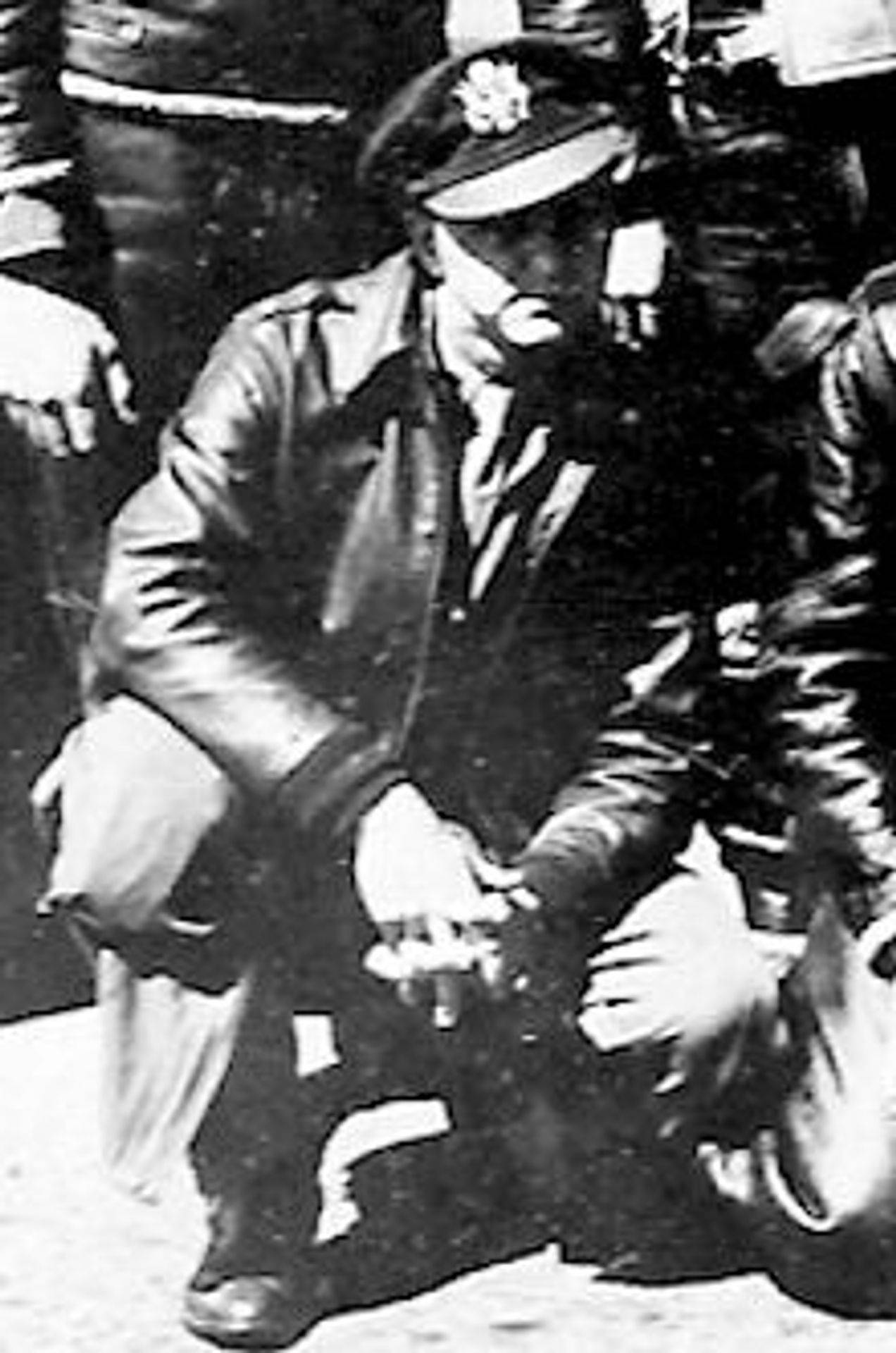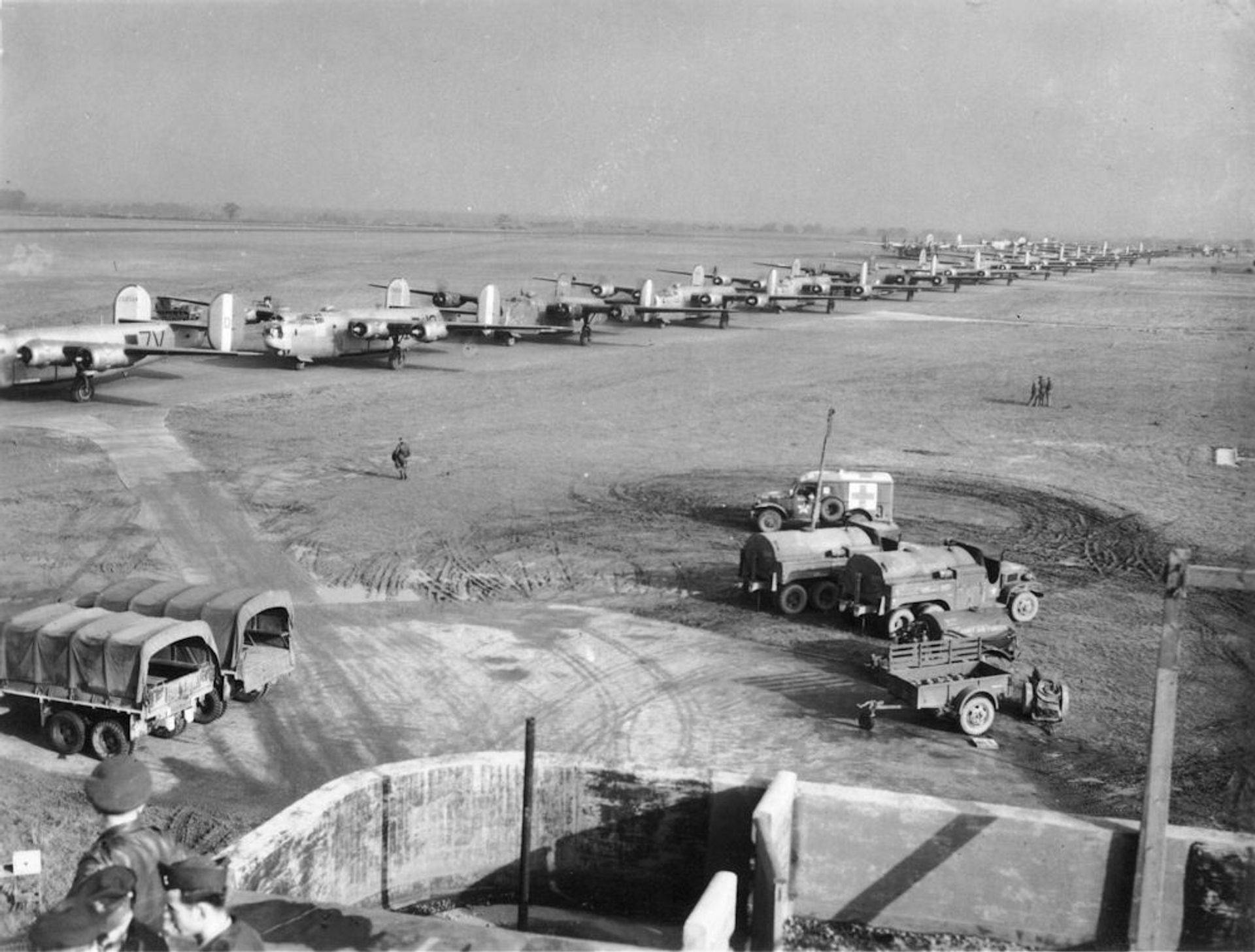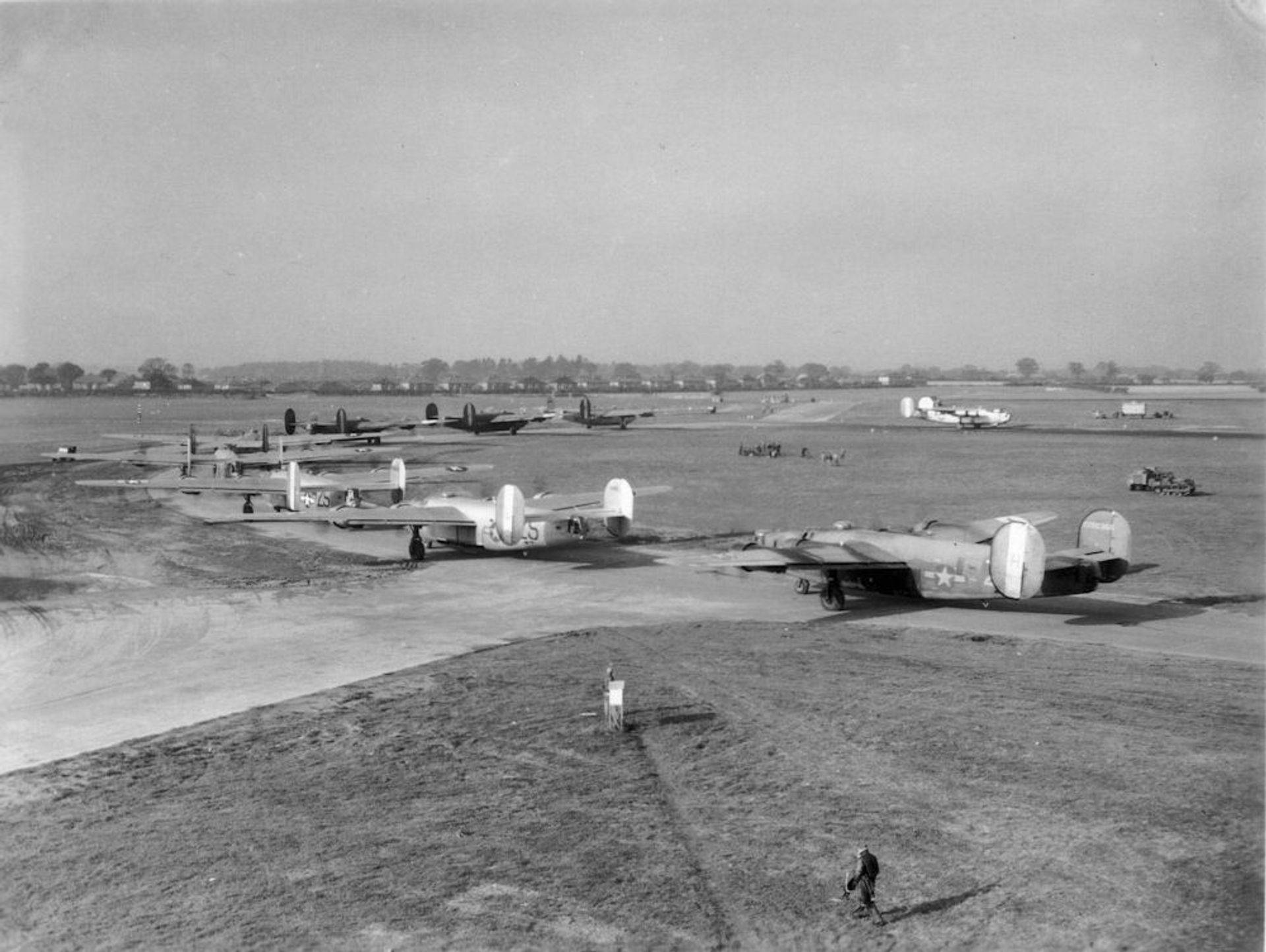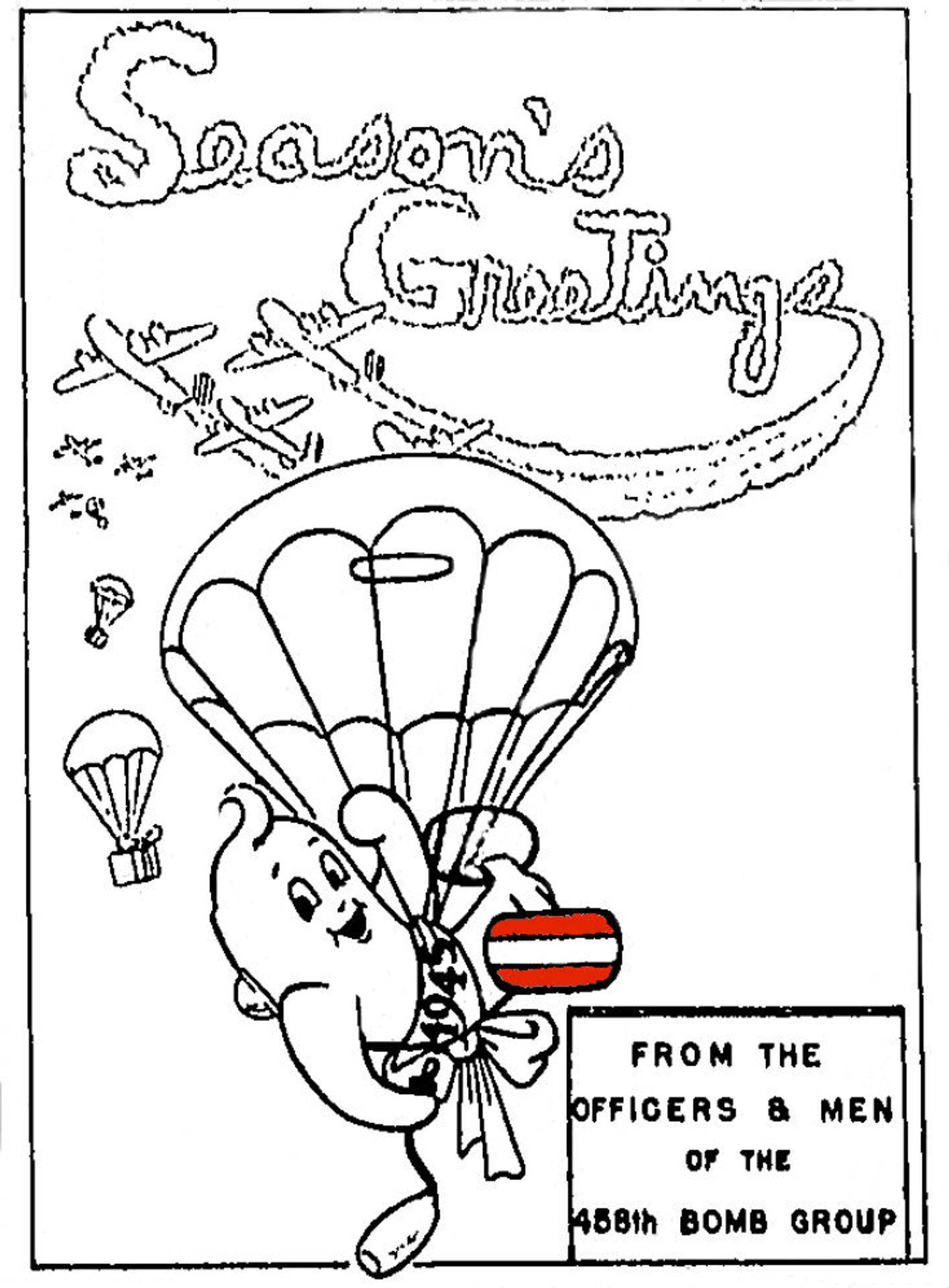458th Bombardment Group (H)
Mission Narrative
December 1944
458TH BOMBARDMENT GROUP (H)
HISTORY
SUMMARY OF OPERATIONS
December will be long remembered as the month when Von Runstedt started his great counter offensive against our ground forces, and almost forced his way to his objective, the Meuse River. It will be remembered by the air forces as a slow starting month, where on many a day we chaffed at the bit, cursing the weather, the all important factor that was keeping us grounded. Then, when the big German attack came, the Hun attacked during a period when he knew the air forces would not be able to operate. A tribute to his evaluation of the Allied power in the air, and the importance of striking when the ground forces would be without the aid of their “Buddies in the Sky”.
We sat by silently for days, gnashing our teeth and, like Elijah praying to Bael, we silently offered our prayers for a let up in the weather so that we could be airborne and help our brothers on the ground. And as the Lord answered Elijah, so did He answer our prayers, as on the 24th the weather cleared and we started a 12 day air offensive which lasted until 3 January 1945. During this lengthy offensive we struck at the Hun’s lines of communications, marshalling yards and bridges, and our efforts combined with the never-to-be-forgotten efforts of the ground forces stopped the Hun just four miles from his objective and started pushing him back.
Our tenth month of operations in the ETO started on 4 December when we attacked the M/Y at BEBRA, 20 miles SSE of KASSEL. Led by LT COL WILLIAMSON and CAPT QUINN, 18 of our A/C were over the target, 177×550 GP’s and 32 M-17’s on the target with the aid of GH equipment with unobserved results due to 10/10th cloud coverage.
Another M/Y was to be our victim on the 6th, namely our old friend BIELEFELD. Our bomb load of 126×1000 GP’s was dropped by our formation of 17 A/C led by LT COL HOGG and MAJOR DARELIUS. Although the bombing was accomplished with the aid of H2X equipment, a 50 second visual correction was made through breaks in the clouds with the following results: crews from lead squadron report good pattern in M/Y. Second squadron slightly to SE of M/Y. No bursts visible in SAV’s of lead section due to cloud cover. SAV’s from high right section show small number of bursts 1800 feet east of the M/Y, however, major portion of pattern is covered by cloud.

We were not alerted again until the 10th and on that day we attacked the M/Y at BINGEN, 30 miles SW of FRANKFURT, at [the] junction of Rhine and Mosselle Rivers. MAJOR JAMISON [and] 1ST LT WAGNER [left] led our formation of 18 A/C, dropped 728×100 GP’s and 34 M-17’s on GH lead with unobserved results. However, marker bombs from all groups and wings were well bunched and GH lead felt he had a good run.
We were up again on the following day the 11th, still hammering at the Hun’s communication lines. Our large formation of 43 A/C attacked the MARSHALLING YARDS at HANAU located 10 miles east of FRANKFURT. The formation was led by MAJOR’S HINCKLEY, BETZOLD, BREEDING and CAPT’S BOOTH and QUINN. A large bomb load of 250×1000 GP’s were dropped on the primary target by H2X methods through 10/10ths undercast with unobserved results.
After PFF bombing we were fortunate enough on 12 December to run a visual bombing, the first one in a long while. Not contented that HANAU M/Y was rendered inactive on the 11th we were once again…
[Narrative is missing a page here. The 458th again went to HANAU on December 12 putting 39 A/C over the marshalling yards and releasing 443×500 GP’s. Between this date and the 24th, there were a total of five missions planned. Four of these were scrubbed and the fifth, on December 18th to the marshalling yards at KOBLENZ, was recalled over the Dutch Islands. No sortie credit was given, and all A/C but one returned to Horsham with their bombs.]


December 24, 1944
(Photos: Rick Rokicki)
Day after day we were forced to stay on the ground due to the prevailing poor weather. But, on the 24th comes the magic word – “Good weather ahead for a spell, get in there and make the most of it.” And brother, we did. That self same day we put up the largest formation of A/C the group has ever had in the air at one time. Fifty-nine, yes we repeat, fifty-nine Liberators from this group were over targets. To the ordinary layman, a formation as this would seem to be an armada in itself, but when we considered the number of A/C the VIII AF was putting over Germany this day, we ourselves had to stop, think and gasp. Our objective this day was to eliminate the TROOPS and SUPPLIES at SCHONECKEN and dislocate and delay enemy transportation by disrupting traffic facilities, demolition of storage facilities, cratering roads, leveling buildings, blocking woods and attack towns where reserve troops and supplies were located. Whew, what a huge experiment! What a relief after being grounded to know that at least we were on our way to helping the boys on the ground. The formation was led by LT COL WILLIAMSON, MAJOR’S LaROCHE, JAMISON, CAPT SIMES, and 1ST LT WAGNER. A total bomb load of 1099×250 GP’s was dropped with the following results: 18 A/C WETTELDORF, visual. Crews report some hits on an unidentified road center. Some crews believe bombs hit 20 miles north of Wetteldorf. SAV show good pattern on unidentified town. 17 A/C SCHONECKEN, visual. Crews report good results and SAV show excellent pattern on town. 9 A/C HELLENTHAL (5026-0626) visual. Crews report hits in town, but target not yet identified. 9 A/C PRUM, visual. Crews report very good hits on R.R. and town. SAV not yet identified. A great day for the air forces. The only item which marred our efforts this day was the loss of our A/C 812V, 752nd Squadron, piloted by 1ST LT C. A. GIESEN. The story gathered at interrogation was that shortly after “Bombs Away” A/C 812V was seen to receive a direct hit just aft of the bomb bay. The A/C split in half and the tail was blown away. One crew reports that when A/C blew up, they followed it visually to the ground where it exploded and that no one was seen to leave A/C. Two crews reported seeing one ‘chute, but majority claim that no ‘chutes were observed. (See MIA section for names)
We understand that on Christmas Day of 1943 no A/C were over enemy territory, and we justly think it should be so in honor of that holy day. But, we were not surprised to find ourselves alerted Christmas Day, and rather than feel it sacrilegious to be bombing this day, let us rather think [of] it as a Christmas present to the boys battling on the ground under the worst conditions imaginable. Let us just call our efforts this day, a present to the ground forces. Still following up closely in support of the ground operations, our assigned target this day was RR TRACKS and YARDS at PRONSFELD, GERMANY. Twenty-four of our A/C were over the targets led by CAPT’S LAMERS and QUINN, dropping 348×300, 20×250 GP’s and 46 M-17 incendiaries with the following results: 16 A/C attacked PRONSFELD visually. Crews report incendiary bombs dropping on R.R. tracks and GP bombs over and short of R.R. SAV’s show bombs hitting 1300 feet NE and 1200 feet N of assigned MPI. GP’s hit highway and a few incendiaries hit R.R. tracks. 8 A/C attacked PELM visually. Crews report hits on R.R. track near town. SAV’s show hits on R.R. track in town. Another good day for the 458th.
The weather still held good and we were up again on the 27th continuing our attack on communication and transportation, this target being the M/Y at NEUNKIRCHEN which was reported to be filled with rolling stock and troops. A death blow at this high priority target would certainly slow up the Hun in his attempt to rush troops to his new offensive penetration. Our formation of 18 A/C was led by LT COL WILLIAMSON, and MAJOR BETZOLD. A total bomb drop of 298×250 GP’s and 25 M-17’s were released with the following results: all A/C attacked the primary, strike photos show that both squadrons hit smoke pattern of the group ahead.
[Flak map at left for December 27, 1944 courtesy Lawrence Fick – Click on map for larger view]
On the following day we were again airborne hitting the same type of target, the M/Y at ST. WENDEL. Although 26 A/C were over the target area, due to malfunctions in the GH Lead, no bombs were dropped. Rather rough to bring our bombs back but we could not take any chances of dropping on friendly troops.
After one day of poor weather we continued again on the 30th with a GH mission on the NEUWIED bridge just NW of COBLENZ. Twenty-seven A/C led by MAJOR JAMISION, CAPT’S QUINN and WILLIAMS dropped 155×1000 GP’s with unobserved results.
We still had to finish out the old year, so on the 31st we attacked the LUTZELL BRIDGE at COBLENZ. It was interesting to hear from higher headquarters that attacks of this nature were really proving effective as reports from German PW’s revealed that it took one unit 5-8 days to reach the front after arriving on the west side of the Rhine, and this had to be accomplished on bicycles. We hope that the Hun’s bicycles did not have three speeds and that they did not carry bicycle pumps, serves the damn fools right, don’t it? Twenty-seven A/C led by LT COL O’NEILL, MAJOR BETZOLD and CAPT BOOTH dropped 88×2000 GP’s using GH methods with unobserved results. [Lt Burman crew crash land on Continent]
And so ushered out 1944, and our fervent hopes go high that we will have this fracas over with before another year ends.
| STATISTICS | |
|---|---|
| Sorties for Month | 11 |
| A/C Attacking | 282 |
| Tonnage on Targets | 807 |
| MIA | 1 |
| Sorties to Date | 162 |
| AZON Sorties | 10 |


